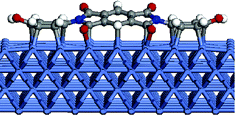| Mike's Pages |
Links |
Theoretical Study on Polyimide-Cu(100)/Ni(100) Adhesion
Jia Zhang, Michael B. Sullivan, Jianwei Zheng, Kian Ping Loh and Ping Wu
Chem. Mater., 2006, 18, 5312-5316.
Department of Chemistry, National University of Singapore, 3 Science Drive 3, Singapore 117543, Department of Mechanical Engineering, National University of Singapore, Singapore S117576, Institute of High Performance Computing, Capricorn, Singapore Science Park II, Singapore 117528
Received December 28, 2005. Revised Manuscript Received August 31, 2006

ABSTRACT:
The interfacial properties of polyimide (PI)/M(100) (M ) Cu and Ni) were investigated using density functional theory (DFT). A PMDA-ODA monomer unit was used to represent the full PI and the surface was represented by periodically repeated slabs. PI prefers the bridge and top sites on a Cu(100) surface but only forms weak C=O-Cu interactions. PI favors the bridge site on a Ni(100) surface and can form strong C-Ni, N-Ni, and C=O-Ni bonds. The adsorption energies of PI on Cu(100) and Ni(100) surfaces are -0.58 and -4.7 eV, respectively. Compared to the adsorption energies of O and O2 on a Cu(100) surface, the adsorption of PI on Cu(100) is not energetically favorable, which leads to the easy oxidation of Cu particles in a Cu/PI nanocomposite. The good adhesion at PI/Ni(100) suggests that Ni is a better candidate as a metal filler compared to Cu in the metal-polyimide composite.
DOI: 10.1021/cm052865n